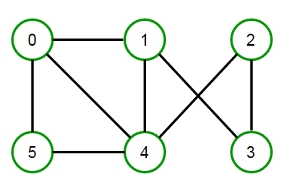Graph Colouring
Graph Coloring Problem
Graph coloring (also called vertex coloring) is a way of coloring a graph’s vertices such that no two adjacent vertices share the same color. This post will discuss a greedy algorithm for graph coloring and minimize the total number of colors used.
For example, consider the following graph:

We can color it in many ways by using the minimum of 3 colors.



Please note that we can’t color the above graph using two colors.
Before discussing the greedy algorithm to color graphs, let’s talk about basic graph coloring terminology.
K–colorable graph:
A coloring using at most k colors is called a (proper) k–coloring, and a graph that can be assigned a (proper) k–coloring is k–colorable.
K–chromatic graph:
The smallest number of colors needed to color a graph G is called its chromatic number, and a graph that is k–chromatic if its chromatic number is exactly k.
Brooks’ theorem:
Brooks’ theorem states that a connected graph can be colored with only x colors, where x is the maximum degree of any vertex in the graph except for complete graphs and graphs containing an odd length cycle, which requires x+1 colors.
Greedy coloring considers the vertices of the graph in sequence and assigns each vertex its first available color, i.e., vertices are considered in a specific order v1, v2, … vn, and vi and assigned the smallest available color which is not used by any of vi’s neighbors.
Greedy coloring doesn’t always use the minimum number of colors possible to color a graph. For a graph of maximum degree x, greedy coloring will use at most x+1 color. Greedy coloring can be arbitrarily bad; for example, the following crown graph (a complete bipartite graph), having n vertices, can be 2–colored (refer left image), but greedy coloring resulted in n/2 colors (refer right image).


Output: The color assigned to vertex 0 is BLUE The color assigned to vertex 1 is GREEN The color assigned to vertex 2 is BLUE The color assigned to vertex 3 is RED The color assigned to vertex 4 is RED The color assigned to vertex 5 is GREEN
The time complexity of the above solution is O(V × E), where V and E are the total number of vertices and edges in the graph, respectively.
Applications of graph coloring:
The problem of coloring a graph arises in many practical areas such as pattern matching, designing seating plans, scheduling exam timetable, solving Sudoku puzzles, etc.
Last updated
Was this helpful?